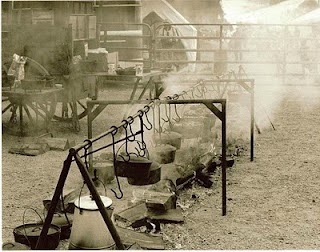The word of the day was grub; as in the slang
word for food used by cowboys in the 1880s. It was called substandard slang by
the author of the article I read. But that is not what intrigued me. What got
my attention was the phrase “grub was served up by the chuck wagon”. Chuck wagon, I have always wondered why it
was called a chuck wagon. Once upon a time I thought it was because the wagon
belonged to a guy named Chuck. NOT true.
A Texas rancher named Charles Goodnight
“invented” the first chuck wagon. Concerned about feeding his cow hands while
they were on cattle drive fueled his creativity and he converted a Studebaker
wagon into a place for the cook to store, prepare and transport the items
needed to feed the crew. Yes, you read
that right, Studebaker as in the car, wagon.
Chuck wagon Catering Company original 1895 Studebaker Chuck wagon
The Studebaker family came from Holland and arrived in America at the
Port of Philadelphia in 1736. On a
census from Pennsylvania dated 1798 the occupation of the men of the family was
listed as wagon makers. In 1835 they are found in Ohio and John Studebaker and
5 of his sons list their trade as wagon makers.
1852 members of the family are in South Bend, Indiana. Another family
member is in Placerville California 1n 1849 making wheelbarrows for
miners. 1857 found family members
building wagons for the United States Army. In 1895 Mr. Fish who had married
Grace Studebaker was toying with the idea of a horseless carriage and in 1904
Studebaker was manufacturing gasoline powered motorized vehicles.
About one third of the wagons crossing the
prairies during the migration toward Oklahoma and beyond were Studebaker wagons.
Our rancher, Mr. Goodnight used a wagon
that had seen service in the Military during the late Civil War.
The food served from a chuck wagon was easily
stored, preserved and cooked such as salted meats, dried meats, beans coffee
and sourdough biscuits. The word chuck comes from a word used on ships during
the early 1800s to mean biscuit, bun, scone or muffin. The closest word I could find was a Swedish
word, kex which translates to biscuit.
In the late 1600s chuck referred to a very cheap cut of beef in English
market places.
The chuck wagon was not
named chuck in honor of Charles Goodnight; even if his good friends did call
him Chuck.
This week we present the Artz of Chuck Wagon.




















